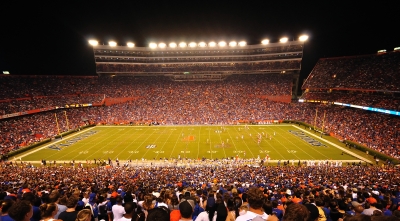 Remember Saturday afternoons and the big football games—homecoming, parties, dances and rallies—what could be better? Student tickets were free and alums found a reason to return. Student-athletes went to class and graduated in four years. They earned their scholarship by working on campus. Players had personal responsibilities. And so it was . . . fifty years ago.
Remember Saturday afternoons and the big football games—homecoming, parties, dances and rallies—what could be better? Student tickets were free and alums found a reason to return. Student-athletes went to class and graduated in four years. They earned their scholarship by working on campus. Players had personal responsibilities. And so it was . . . fifty years ago.
Today, nothing is free, it’s big business! Students are charged an athletic fee or pay to attend. Tickets for alums cost hundreds of dollars. Players come and go on their way to the NFL. Some athletes stay and a few graduate. The coaches are there to win; nothing stands in their way.
Earlier this year the National Labor Relations Board ruled Northwestern University football players were employees, and had the right to unionize. During the last week, the courts ruled against the NCAA, allowing college players to receive compensation for the use of their names and images. Then, the last straw fell when the NCAA caved in to the “Big Five” conferences, allowing the ACC, Big 12, Big Ten, SEC and Pac 12 plus Notre Dame to form their own rules.
The Mythical Cash Cow
University athletics raise millions of dollars; unfortunately, the programs spend millions more. Separating governmental, student, and university subsidies from the athletic budgets of the nation’s major programs for 2005-2009, a recent study found that only eight institutions broke even or made a profit in each of the five years. The true winners were Georgia, Iowa, Louisiana State, Michigan, Nebraska, Penn State, Oklahoma, and Texas at Austin.
The millions lost by the other 118 Division I institutions could have been used to support academic programs. Further, the study found the problem is getting worse with increases in athletic spending growing a rate double that of academic spending.
Proponents justify athletic spending as investment in legislative and donor goodwill, enrollment enhancement, and community relations. To the contrary, studies find no link between winning teams and institutional success as measured by the number of applications, increases in fundraising dollars or state appropriations.
The Ethical Charade
Nowhere in sports is the question of ethics more widely debated than in college football. There are thousands of outstanding young men playing and some honest coaches too, but the football “macho culture” separates itself from all other sports. Urban Meyer recently made the point when talking about his 2008 championship team. The team was out of control. “You can’t reason with a wild animal,” Meyer said. He was right on target—a majority of the starters on that team were arrested or suspended for violating NFL drug policies.
Questions of ethics are not limited to the players. Football coaches are regularly cited for NCAA violations; yet, their salaries continue to escalate. Nick Saban’s salary at the University of Alabama tops them all. His contract for nearly $7 million per year is almost fourteen times that of the University president. Interestingly, no one cares that only half of Saban’s players graduate.
The Future
By their action, the NCAA has said everything is okay, give the big guys more power and it’ll be all right. Forget that! It’s time to tell it the way it is—COLLEGE IS A MINOR LEAGUE TRAINING GROUND FOR THE NATIONAL FOOTBALL LEAGUE. The NCAA and NFL should create a Pro Football Division. Composed of sixty-five to seventy of the biggest powers, it should be managed by a Board of professional team owners and university presidents.
Players would be paid $15,000, $20,000 or $25,000 by the NFL through a pool of dollars distributed equally to each school. Universities would continue to pay for scholarships. To maintain equity, Pro Division teams would play only institutions in their own division. There’ll be no buying a win by playing a school with fewer scholarships. Besides, there’s no reason why institutions couldn’t play each other twice in a year. The division would establish its own policies, rules and regulations, and have a multi-team national championship playoff system.
It’s time to treat football athletes in a manner they deserve and to crown a champion determined by how well teams play in the national championship game.
Guest Editorial by Les Cochran, President Emeritus, Youngstown State University, News-Press, Fort Myers, Florida, Monday, August 18, 2014.

0 Comments
Leave a reply →